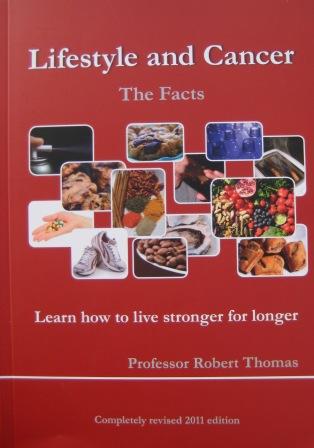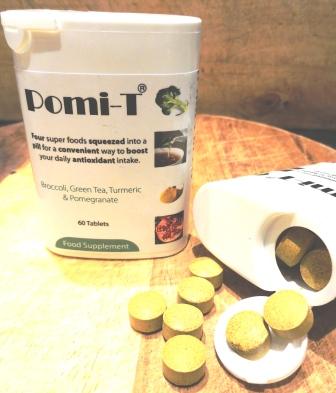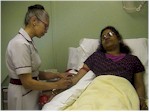|
|
|||||||||||

|
|||||||||||
| Read free chapter or Paula Radcliffe's preface | |||||||||||
|
Ongoing
research |
|||||||||||

|
|||||||||||
The Asian language video project
|
|
|||||||||||

|
|||||||||||
| Read free chapter or Paula Radcliffe's preface | |||||||||||
|
Ongoing
research |
|||||||||||

|
|||||||||||
As a profession oncologists
(cancer doctors) are increasingly realising the importance of patient
information and education as major part of daily oncology practice. Most
patients and relatives now quite rightly expect sufficient information to
allow them to actively participate in the decision making process. Only a
minority of patients want to let the doctor make decisions for them without
their informed input, yet, despite the global revolution in communications,
patients’ still report considerable difficulty obtaining enough reliable
information and
many remain dissatisfied. Our multi-centre trial, for example, found that 69% of
300 patients felt the information could be improved and The National Cancer
Alliance and The Audit Commission found a similar trend. Furthermore, there was
a significantly worse satisfaction rate among patients who indicated they were
from ethnic minority groups. It was also these patients who recorded higher
levels of anxiety and a stronger need to seek information outside the clinic.
Whereas investment in educational and information strategies was previously
overlooked, and left to charitable or ad hoc sources, pressure from central
initiatives such as Clinical Governance, Calman Hine and Chai are now finally
encouraging routine funding in this area.
 Information materials
are, clearly no substitute for good verbal discussions in conveying treatment -
related information to patients. Educational
materials however have a useful role in allowing patients to continue the
learning process outside the sterile, and often alien environment of the
hospital clinic in the comfort of their own home, in their own time, in the
presence of friends and relatives who may not have attended the hospital
consultation. A wide
variety of information tools are required for a comprehensive service, but video
seems to be a particularly attractive option for all patients, and particularly
those from ethnic minorities. It combines vision, sound and movement, and
a well-made film presents a large quantity of practical information in a short
period of time.
Information materials
are, clearly no substitute for good verbal discussions in conveying treatment -
related information to patients. Educational
materials however have a useful role in allowing patients to continue the
learning process outside the sterile, and often alien environment of the
hospital clinic in the comfort of their own home, in their own time, in the
presence of friends and relatives who may not have attended the hospital
consultation. A wide
variety of information tools are required for a comprehensive service, but video
seems to be a particularly attractive option for all patients, and particularly
those from ethnic minorities. It combines vision, sound and movement, and
a well-made film presents a large quantity of practical information in a short
period of time.
An
additional attitudinal survey found that 89% of cancer patients felt that
information videocassettes, in addition to written material, would be helpful
and on a practical basis 87% had easy access to a video player. This format is
also an attractive option for patients with reading difficulties, which may be
as high as 15% in some areas of the United Kingdom and often higher in ethnic
minority concentrated areas.
 Four years ago a dedicated team of patients,
relatives, doctors, nurses, radiographers and pharmacists made a 21minute film
designed to be given to patients to take home prior to chemotherapy or
radiotherapy. The film was introduced by Sue Lawley and narrated by Anton
Rodgers both experienced and popular TV personalities in the UK. It gave an
initial overview of therapies with clear indications of the associated risks. Separate sections on radiotherapy and chemotherapy (demarcated by a
different coloured background and an "R" or a "C" in the
corner of the screen) featured patients
describing their own experiences, side effects and the methods used to alleviate
them. Before its routine distribution the impact of the film on 220
patients was evaluated in a national multicentre,
randomised trial. Patients who received the film prior to therapy watched it on
average 2.5 times and had a significantly lower treatment associated
psychological morbidity and higher satisfaction, than the control group. The
film is generic and free from commercial bias (The £40,000 cost of the film was
raised entirely from educational grants). This evaluation won the NHS
Four years ago a dedicated team of patients,
relatives, doctors, nurses, radiographers and pharmacists made a 21minute film
designed to be given to patients to take home prior to chemotherapy or
radiotherapy. The film was introduced by Sue Lawley and narrated by Anton
Rodgers both experienced and popular TV personalities in the UK. It gave an
initial overview of therapies with clear indications of the associated risks. Separate sections on radiotherapy and chemotherapy (demarcated by a
different coloured background and an "R" or a "C" in the
corner of the screen) featured patients
describing their own experiences, side effects and the methods used to alleviate
them. Before its routine distribution the impact of the film on 220
patients was evaluated in a national multicentre,
randomised trial. Patients who received the film prior to therapy watched it on
average 2.5 times and had a significantly lower treatment associated
psychological morbidity and higher satisfaction, than the control group. The
film is generic and free from commercial bias (The £40,000 cost of the film was
raised entirely from educational grants). This evaluation won the NHS  2000/1
communication prize, a BMA film prize and contributed toward the 2000/1 Hospital
Doctor Magazine prize. In the UK Cancer BACUP has adopted it as their official
cancer video and likewise in Australia the Victoria Cancer Confederation. It has
been digitised and can be viewed free on the UICC patient information web site
Geneva and in the UK on the cancernet.co.uk website.
2000/1
communication prize, a BMA film prize and contributed toward the 2000/1 Hospital
Doctor Magazine prize. In the UK Cancer BACUP has adopted it as their official
cancer video and likewise in Australia the Victoria Cancer Confederation. It has
been digitised and can be viewed free on the UICC patient information web site
Geneva and in the UK on the cancernet.co.uk website.
In
view of the large Italian speaking population in the Bedford area links were
forged with the medical attaché at the Italian embassy and charitable
information organisation in Rome called AIMaC. A cultural and literal
translation was made with Italian patients both locally and from Italy. It is
now offered free to all Italian-speaking patients in Bedford and Cambridge and
has been very warmly received. In
Italy and other Italian speaking communities internationally it is widely
distributed by AIMaC.
Urdu, Hindi, Gujarat & Bengali.
 Making a film for different cultural groups requires a great
deal of preparation if it is to be accepted and used by the target audience.
The Italian film, for example, had several re-editing sessions and four
complete re-shoots to get it right. The final version even dropped our homely
distinguished guest presenter Antonio Carlusio for a young, attractive,
glamorous popular TV presenter who was more acceptable to the Italian viewer,
even on the sober topic of cancer therapies. Within Asian ethnic groups
inappropriate clothing, the wrong gesture or comment can easily offend
especially in the emotional milieu of newly diagnosed cancer. The Salman Rushdie
affair also points out that an insensitive religious remark can, not only lead
to poor acceptance but even hostility. All these issues were considered in detail by the Editorial
panel before rewriting the script. A year was also spent visiting hospitals in
high ethnic areas, religious
groups, charitable and government organisations to
seek their opinion and feed back. We
also showed the film to more than twenty patients from each cultural group
before starting production.
Making a film for different cultural groups requires a great
deal of preparation if it is to be accepted and used by the target audience.
The Italian film, for example, had several re-editing sessions and four
complete re-shoots to get it right. The final version even dropped our homely
distinguished guest presenter Antonio Carlusio for a young, attractive,
glamorous popular TV presenter who was more acceptable to the Italian viewer,
even on the sober topic of cancer therapies. Within Asian ethnic groups
inappropriate clothing, the wrong gesture or comment can easily offend
especially in the emotional milieu of newly diagnosed cancer. The Salman Rushdie
affair also points out that an insensitive religious remark can, not only lead
to poor acceptance but even hostility. All these issues were considered in detail by the Editorial
panel before rewriting the script. A year was also spent visiting hospitals in
high ethnic areas, religious
groups, charitable and government organisations to
seek their opinion and feed back. We
also showed the film to more than twenty patients from each cultural group
before starting production.
The Bollywood actor and star of A Passage to India,
Saeed Jaffery and the Eastender's star, Rani Singh gave invaluable enthusiastic
support for the project. These actors well know  both to the Asian and non-Asian
communities not only gave an enormous boost of professionalism for the project
but are likely to improve the trust in the information by providing a familiar
face for users when offered the film in the clinic and when it is watched at
home. In these times of global health care imbalance, at least on our own doorstep we can strive toward giving all patients equal
opportunity to understand their treatment options. We are grateful to The National Lottery and NHS executive for
providing the funding for this project
both to the Asian and non-Asian
communities not only gave an enormous boost of professionalism for the project
but are likely to improve the trust in the information by providing a familiar
face for users when offered the film in the clinic and when it is watched at
home. In these times of global health care imbalance, at least on our own doorstep we can strive toward giving all patients equal
opportunity to understand their treatment options. We are grateful to The National Lottery and NHS executive for
providing the funding for this project  and the Royal College of Radiologist for
it’s support and help. These films hopefully, if used correctly, will help to
iron out the inequalities of provision of oncology information in the United
Kingdom.
and the Royal College of Radiologist for
it’s support and help. These films hopefully, if used correctly, will help to
iron out the inequalities of provision of oncology information in the United
Kingdom.
For more information on the background of this project, the production of this film and other Asian information sources.
For copies of any of these Asian films contact:-

CancerBacup, 3 Bath Place, Rivington St, London EC2A 3JR
Nurse: 0808 800 1234. Fax:
020 7696 9002 info@cancerbacup.org
Web: cancerbacup.org.uk